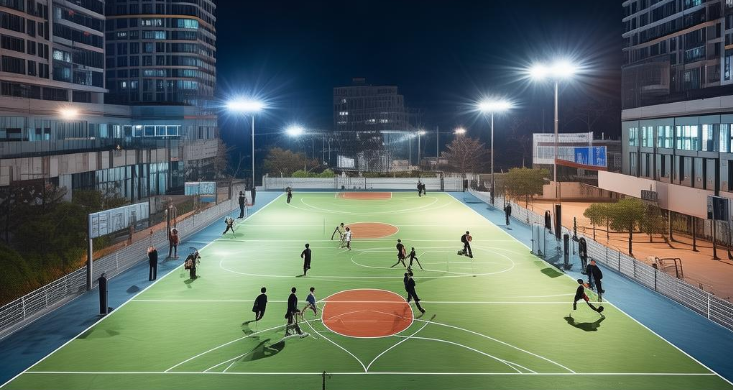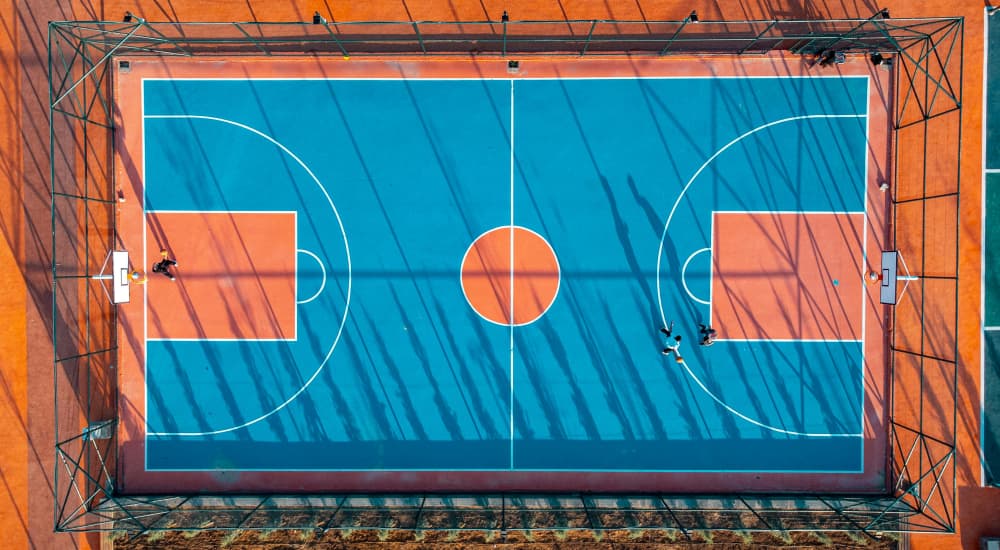How to Choose Basketball Court Lights?
Ever played basketball at night and struggled to see the ball? Or bought court lights only to find they're too dim, too glarey, or a waste of electricity?
Choosing the right basketball court lights doesn't have to be complicated. This guide breaks down the key steps to pick lights that fit your space, budget, and needs—whether it's a backyard half-court or a community full-court.

Table of Contents
Step 1: Define Your Court Type & Purpose
Step 2: Understand the 3 Key Lighting Metrics
Step 3: Choose the Right Fixture Style
Step 4: Evaluate Beam Angle & Light Distribution
Step 5: Confirm Color Temperature & Color Rendering
Step 6: Include Control & Dimming Options
Step 7: Check IP Rating & Durability
Key Takeaways:
For Backyards: Aim for 200-300 lux with wall-mounted fixtures.
For Community Courts: Need 300-500 lux and 0.5 uniformity with pole-mounted lights.
Avoid Glare: Choose fixtures with cut-off optics and mount at 20-30°.
Don't Guess: Always request photometric data (IES files) from the supplier.
Step 1: Define Your Court Type & Purpose
Before choosing basketball court lights, the first step is to clearly define what kind of court you're lighting and how it will be used. Every lighting design — from brightness to layout — depends on these two factors.

(1) Backyard or Half-Court
For small personal courts or driveways, the goal is safe, enjoyable play, not professional-level brightness.
Lighting target: 200–300 lux
Setup: 2–4 fixtures are usually enough
Recommended style: wall-mounted or short-pole LED floodlights
Tips: keep lights angled downward (20–30°) to prevent glare and light spill to neighbors
(2) School or Community Court
These areas host regular games, training, or after-school activities, requiring higher and more uniform lighting.
Lighting target: 300–500 lux with ≥0.5 uniformity
Setup: typically 4–6 poles (8–12 m high) with symmetrical floodlights
Tips: use wide-beam fixtures to cover the entire court evenly and improve visibility for both players and spectators
(3) Indoor Gym or Sports Center
Indoor basketball courts demand consistent brightness and visual comfort without glare.
Lighting target: 500 lux or higher
Recommended style: high-bay LED fixtures or ceiling-mounted panels
Tips: choose lights with low glare (UGR <22) and color temperature around 4000–5000K for natural color rendering
Key takeaway: Start with a clear understanding of your court’s size, environment, and usage frequency. Once those are defined, you can select the right brightness, fixture type, and layout that ensure every shot and pass stays visible and comfortable.
Step 2: Understand the 3 Key Lighting Metrics
Once you’ve identified your court type, the next step is to understand the three essential lighting metrics that determine how well your basketball court will perform at night: brightness (lux), uniformity, and glare control.
These are not marketing terms — they’re the foundation of any professional sports court lighting design.
(1) Brightness (Lux Levels)
Lux measures how much light reaches the court surface. The right brightness ensures players can track the ball, read movement, and play safely.
Court Type | Recommended Lux Level | Typical Use |
Backyard / Half-Court | 200–300 lux | Casual play |
School / Community Court | 300–500 lux | Training, local games |
Competition Court | 500+ lux | Professional or televised matches |
These targets align with IESNA RP-6-15 and EN 12193 lighting standards for recreational and competitive basketball courts.
Tip: When comparing lights, don’t just look at wattage. Two fixtures with the same wattage can produce very different lux levels depending on their optics and mounting height.
(2) Uniformity (U₀)
Uniformity measures how evenly light is distributed across the court.
It’s calculated as the ratio between the lowest and average brightness values.
Recommended minimum: U₀ ≥ 0.4 for recreational play, ≥ 0.6 for competition.
Poor uniformity creates bright spots and dark corners that make play uncomfortable and unsafe.
Tip: Always ask for a photometric layout (IES file) from your lighting supplier — this file visually shows how even the lighting will be before installation.
(3) Glare Control
Even if your court meets the correct lux level, glare can ruin the experience. It causes discomfort, affects visibility, and distracts players.
Use LED fixtures with cut-off optics or asymmetric beam angles to direct light onto the court, not into players’ eyes.
Mount lights at a 20–30° tilt angle and position them outside the main playing line of sight.
For indoor courts, check that the UGR (Unified Glare Rating) is below 22.
Key takeaway: High brightness alone doesn’t guarantee good lighting — uniformity and glare control are equally critical. When reviewing potential LED court lights, always verify the lux level, uniformity ratio, and optical design through photometric data, not just product claims.
Step 3: Choose the Right Fixture Style
Once you know your court type and brightness needs, the next step is selecting the right lighting fixture style. The fixture determines how light is distributed, maintained, and how your court looks at night.
(1) Floodlights
Floodlights are the most common and versatile option for basketball courts. They deliver wide beam angles, powerful brightness, and uniform coverage. For full-size outdoor courts, LED floodlights with asymmetric beam angles (30–60°) help direct light precisely onto the playing area while minimizing glare and light spill.
(2) High Mast Lights
For larger facilities, stadiums, or multi-court complexes, high mast fixtures are ideal. Mounted on poles 12–20 meters high, these lights provide extensive coverage with fewer poles and better light uniformity. They are often used in professional or community sports parks.
(3) Wall-Mounted Fixtures
If your court is located beside a building (like a school gym or residential complex), wall-mounted lights can be a practical option. They save space and installation costs while providing sufficient illumination for small or half courts.
(4) Integrated Pole Lights
These combine the pole and fixture in one sleek unit, suitable for recreational or community courts. Integrated designs are easier to install and maintain, with modern LED versions offering a clean appearance and minimal wiring.
Tip: Always consider glare control and beam direction when selecting fixtures. Choose fixtures designed with visors or asymmetric optics to ensure players and spectators are not blinded during play.
Step 4: Evaluate Beam Angle & Light Distribution
Getting the right beam angle and light distribution pattern is crucial for achieving even coverage and minimizing glare on your basketball court. Even if your lights are bright enough, poor optical design can still cause uneven patches, shadows, or wasted light.
① Understand Beam Angle Basics
The beam angle determines how wide the light spreads from each fixture.
Narrow beam (30°–60°): Focused illumination for tall poles or large full-size courts. Helps achieve long-distance projection.
Wide beam (90°–120°): Suitable for small or half-courts where fixtures are mounted closer to the playing surface.
Tip: Combining different beam angles (e.g., 60° + 90°) can improve uniformity and eliminate dark corners.
② Prioritize Uniform Light Distribution
Uniform lighting allows players to see clearly from every position without eye strain.
Recommended uniformity ratio (Umin/Uavg): ≥ 0.5 for recreational play; ≥ 0.7 for competition.
Use asymmetric optics: These direct light downward and forward, avoiding glare in players’ line of sight.
Avoid overlapping beams: Too many fixtures aimed at the same area cause bright spots and shadows.
③ Verify With Photometric Simulations
Before purchasing, request IES or photometric files from your supplier. This data shows how light spreads and overlaps across your court. A proper layout simulation confirms:
Correct beam coverage for your court dimensions.
Adequate lux levels on the playing surface.
Minimal glare and shadow zones.
Proper beam control isn’t just about brightness — it’s about delivering consistent visibility, visual comfort, and professional-level lighting performance.
Step 5: Confirm Color Temperature & Color Rendering
When choosing LED lights, color temperature and color rendering are just as important as brightness. Both factors directly affect how players perceive the ball, lines, and surroundings — and how comfortable the court feels to the eyes.
(1) Color Temperature (CCT)
For basketball courts, the ideal range is 4000K–5000K, which delivers a bright, neutral white light.
4000K: Slightly warmer tone, comfortable for community and school courts.
5000K: Crisper, daylight-like tone, preferred for professional or televised games.
This balance ensures good visibility without harsh blue tones that may cause eye strain during night play.
(2) Color Rendering Index (CRI)
The CRI measures how accurately light reproduces true colors compared to natural daylight.
Choose CRI ≥ 70–80 for clear visibility of court markings, uniforms, and the basketball itself.
A higher CRI (80+) enhances contrast and depth perception — essential for fast-paced gameplay and video recording.
Tip: Always check the fixture’s datasheet. A good LED basketball court light should list both CCT and CRI values for consistent visual quality.
Step 6: Include Control & Dimming Options
Given that many venues are multi-purpose for multiple sports, a smart lighting system is highly recommended as it seamlessly accommodates basketball court, tennis court, and pickleball court lighting.
With one-touch switching between preset modes and automatic adjustments of illuminance, color temperature, and glare control, the system perfectly adapts to the distinct requirements of each sport, ensuring optimal performance of both tennis court lighting and pickleball court lighting.
(1) Why Lighting Control Matters
Not every game or event requires full brightness. Having adjustable light levels makes your court more versatile:
Training sessions or casual play: 50–70% brightness is usually enough.
Official matches or tournaments: Full brightness ensures uniform visibility.
Maintenance or cleaning: Minimal light levels are sufficient, reducing power consumption.
(2) Recommended Control Options
Dimming Systems: Look for 0–10V or DALI dimming compatibility — smooth brightness control without flicker.
Zoning Control: Divide lights into sections (e.g., half-court, spectator area) for flexible operation.
Smart Timers & Sensors: Automate lighting schedules and shut off lights when the court is not in use.
Wireless or App-Based Control: Useful for community or school courts where multiple users share access.
Pro Tip: Choose LED fixtures that support instant on/off and dimming without color shift — critical for fast-paced sports like basketball.
Step 7: Check IP Rating & Durability
When choosing LED basketball court lights, durability is just as important as brightness. A well-built fixture ensures long-term performance, consistent light output, and minimal maintenance — especially for outdoor courts exposed to harsh weather.
(1) IP Rating (Ingress Protection)
The IP rating tells you how well a fixture resists dust and water.
Indoor courts: IP40–IP54 is typically enough to protect against dust and humidity.
Outdoor courts: Always choose IP65 or higher to withstand rain, wind, and dust.
Severe climates: IP67 provides extra protection against heavy rain or temporary water immersion.
Tip: Look for fixtures with die-cast aluminum housing and powder-coated finishes — they resist corrosion and help with heat dissipation.
(2) Durability Factors to Consider
Operating Temperature Range: Ensure it performs reliably from –30°C to +50°C, suitable for all-season use.
Shock & Vibration Resistance: Essential for pole-mounted or high-mast lights that face strong winds.
UV & Salt Spray Resistance: For coastal or sun-exposed courts, choose fixtures with UV-stabilized lenses and anti-corrosion coatings.
A durable fixture may cost slightly more upfront, but it ensures years of stable lighting and lower maintenance costs — especially valuable for schools, communities, and sports facilities.
CeramicLite sports lights boast IP66 protection, IK08/IK10 impact resistance - built to withstand -40°C~+45°C outdoor environments, with 5/8/10-year warranties and 51,000H/102,000H long lifespans, perfect for shared pickleball, tennis and basketball courts.
Step 8: Avoid Common Mistakes
Even the best LED court lights can perform poorly if they’re installed or selected incorrectly. Before finalizing your lighting plan, double-check these common pitfalls — they’re easy to avoid and can make a huge difference in performance and comfort.
① Overlooking Uniformity
A bright court doesn’t always mean a well-lit court. Uneven light causes glare, shadows, and eye strain.
Tip: Aim for a uniformity ratio (Umin/Uavg) of 0.5 or higher for recreational courts — meaning light is evenly distributed across the entire playing area.
② Mounting Lights Too Low
Low-mounted lights create glare and blind spots for players.
Tip: Follow proper mounting heights — 6–8 m for half-courts and 8–12 m for full-courts — and tilt fixtures at a 20–30° angle for balanced coverage.
③ Ignoring Glare Control
Excessive glare not only affects gameplay but can also cause safety issues.
Tip: Choose fixtures with asymmetric beam optics or anti-glare visors to keep light on the court and out of players’ eyes.
④ Guessing Lux Levels
Never rely on wattage alone — brightness depends on optical design, beam angle, and installation height.
Tip: Always request photometric simulations or IES files from your supplier to verify light levels before purchasing.
⑤ Neglecting Maintenance Access
Lights installed in inaccessible areas make repairs expensive and inconvenient.
Tip: Plan for easy access (e.g., hinged poles or detachable brackets) during installation design.
Avoiding these mistakes ensures your basketball court lighting is not only bright and efficient but also safe, durable, and visually comfortable.
Conclusion
By defining your court, checking lighting metrics, and planning a correct layout, you can select basketball court lights that deliver bright, even, and comfortable illumination for years. Don’t just pick by wattage—design by data.
Ready to Light Your Court?
Stop guessing and start playing with confidence. Tell us your court details, and our lighting experts will provide a free, no-obligation layout plan for you! CeramicLite provides energy-saving, long-lasting professional sports lighting solutions with 10-year warranty!
_thumb.jpg)
